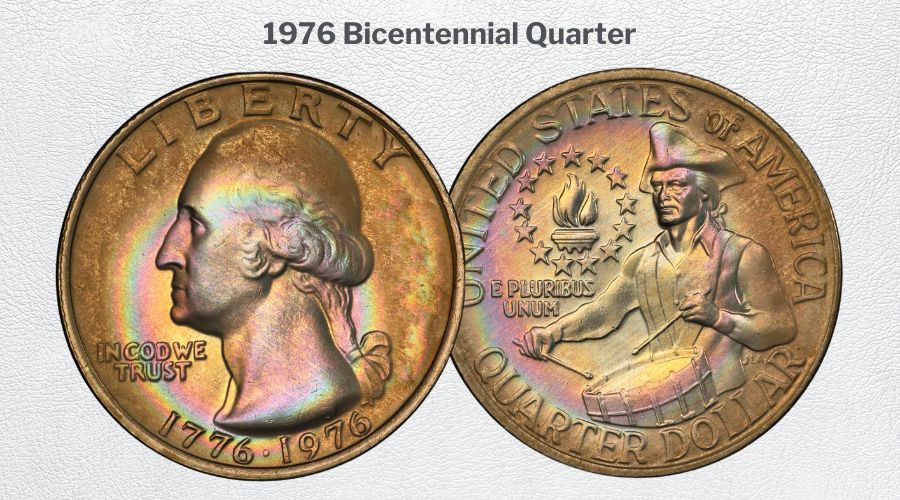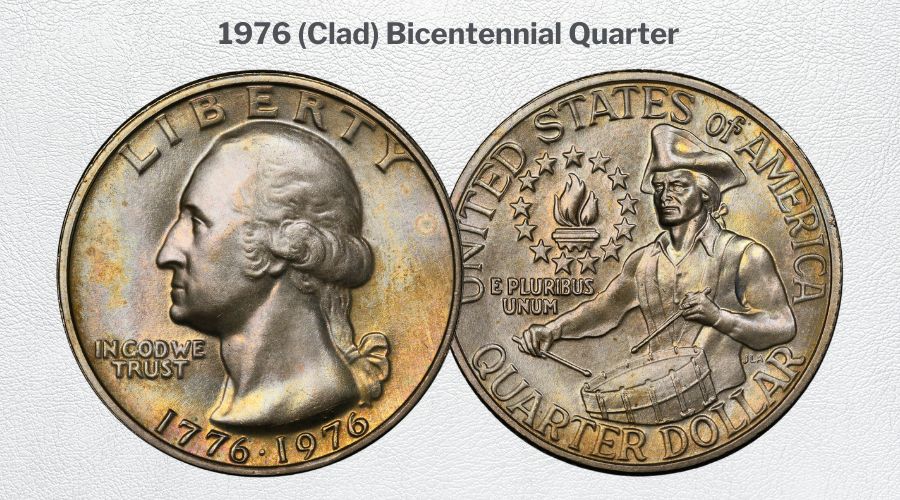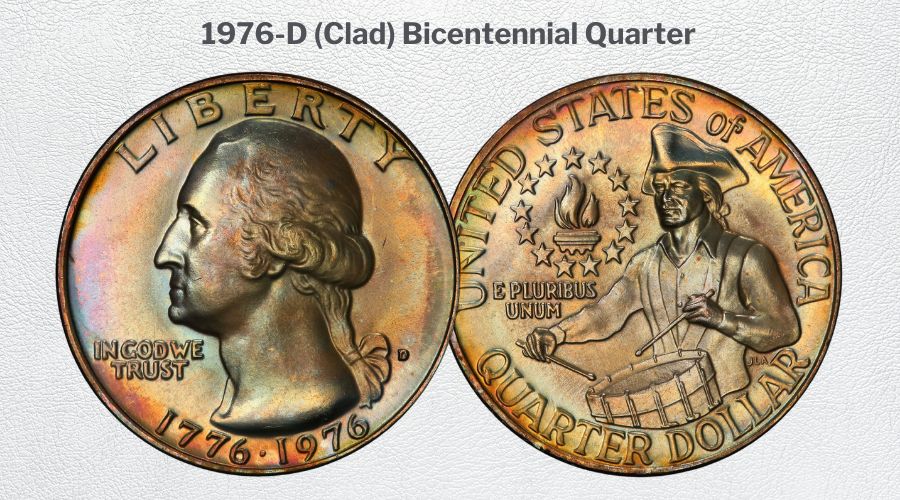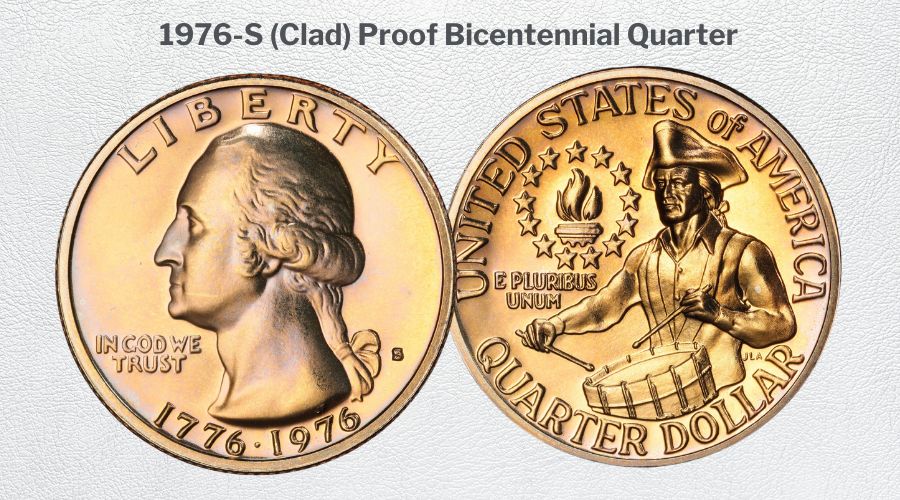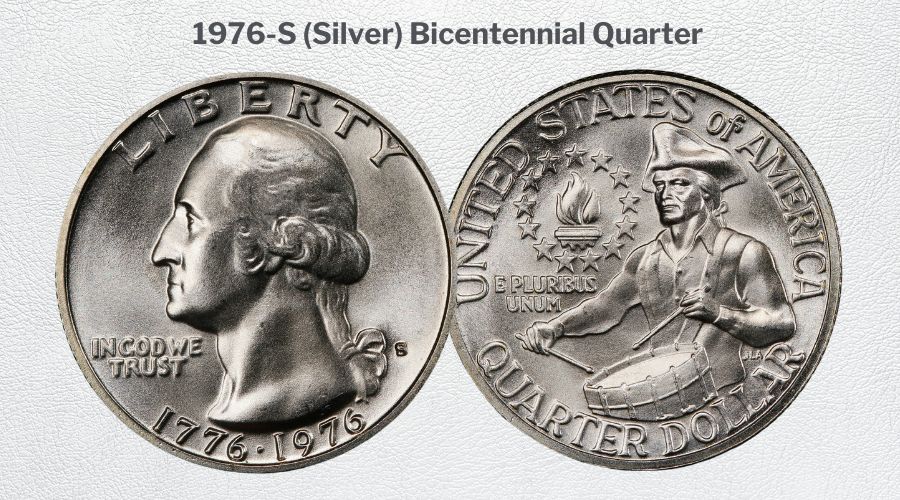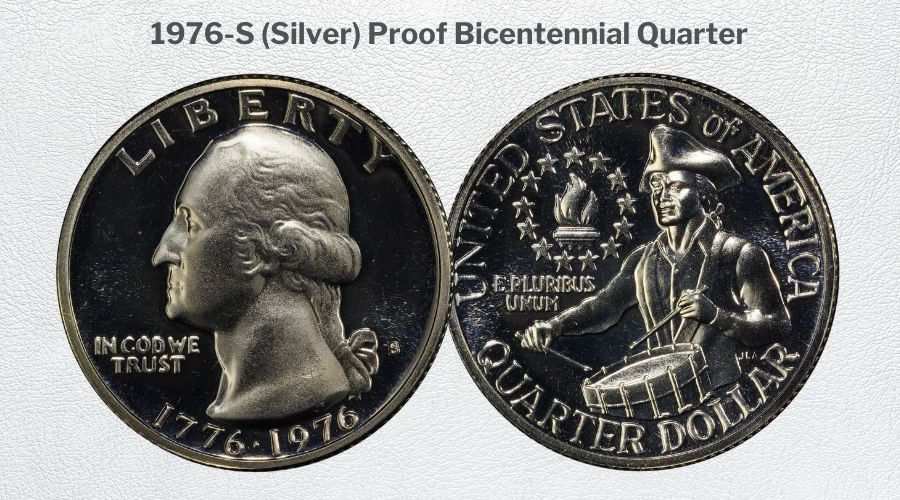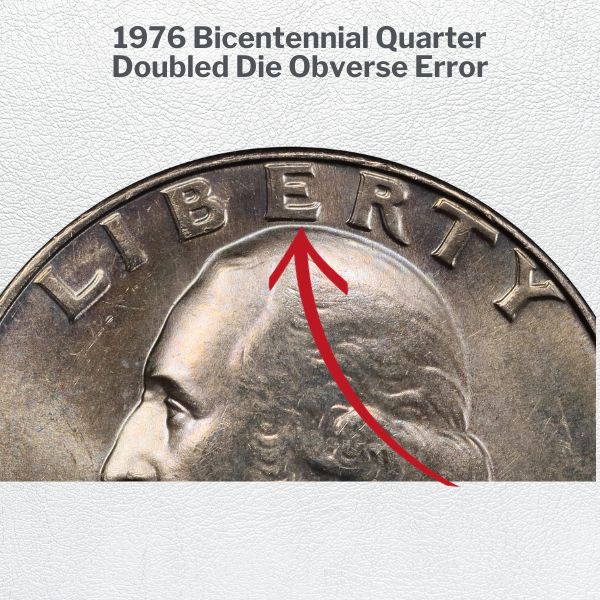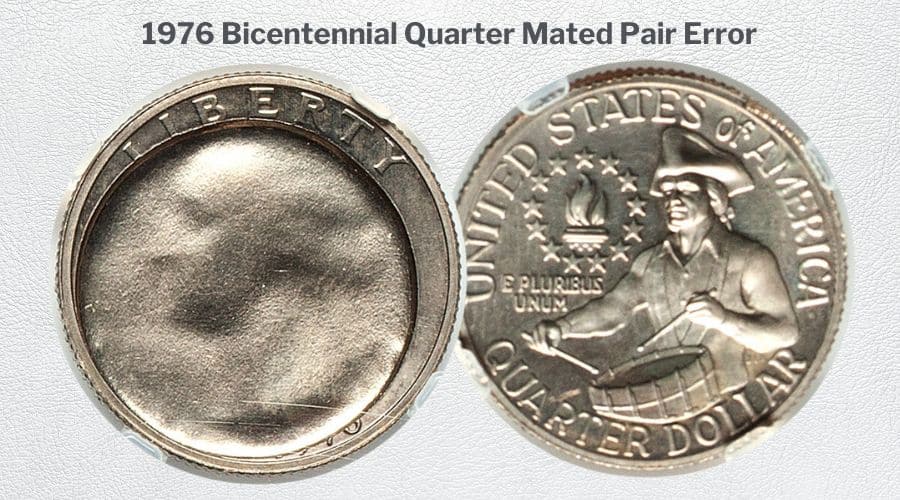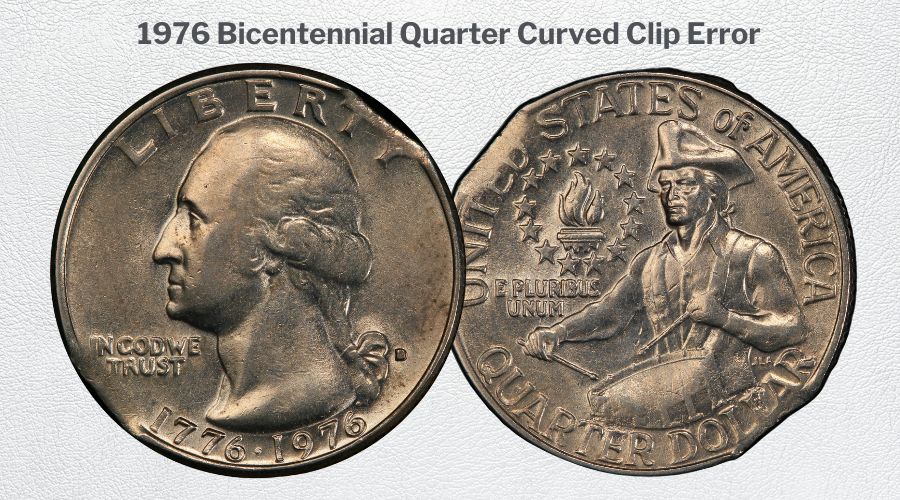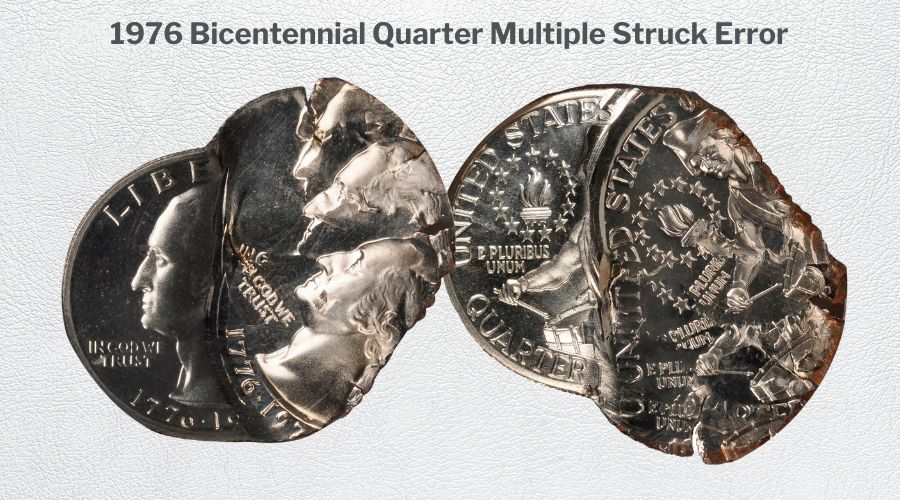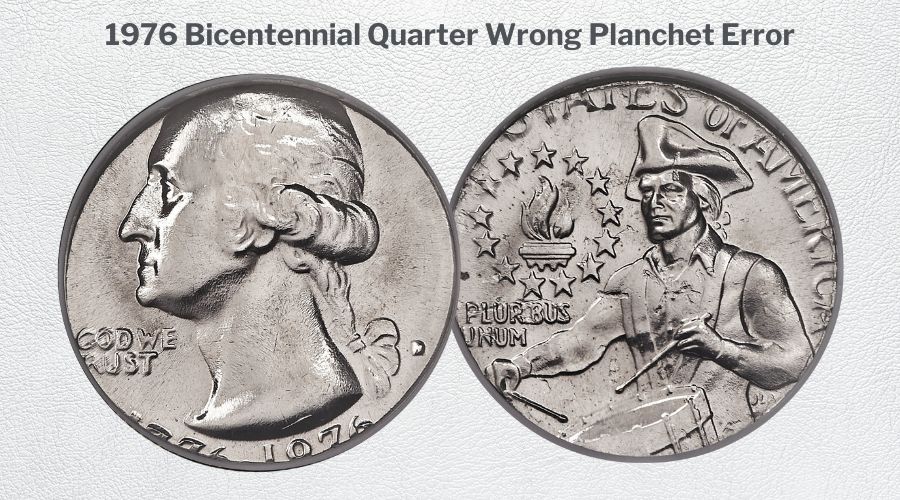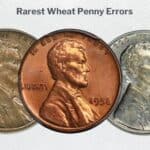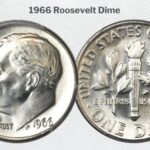The most valuable Bicentennial Quarter was sold for $19,200 in 2019 at Heritage Auctions: the coin’s unique silver composition and high-grade (MS69) rarity make it a coveted piece in the collectors’ market.
Here are the three primary considerations that can help you find the most valuable 1976 Bicentennial Quarters:
- Coin Condition: Regular Strike coins are worth over $9,000 in MS69 or higher, while Proof Coins are worth more than $150 at PR70 DCAM. These are the highest priced in the series.
- Silver Varieties: Some 1976 quarters were made from silver. Some have sold for more than $6,000 at auctions.
- Mint Errors: Major errors such as DDO increase the value of the Bicentennial Quarters up to about $3,000 in the best grade conditions.
The comprehensive guide here will take you through Bicentennial Quarters’ history, design, features, errors, and value in today’s market. Collectors and enthusiasts should pay attention to the trends in the prices and demand to valuate their collectibles better.
Bicentennial Quarter Value Summary
Below is the Mint State Bicentennial Quarter Value Chart based on grade condition and strike:
| Bicentennial Quarter and Coin Grade | 1976 (Clad) No Mint Mark (MS) | 1976-D (Clad)(MS) | 1976-S (Clad) Proof (PR) | 1976-S (Silver) (MS) | 1976-S (Silver) Proof (PR) |
| 60 | $2 | $1.50 | $1 – $5 | $3.50 | $3 – $6 |
| 61 | $2.50 | $2.50 | $2 – $5 | $4 | $4 – $6 |
| 62 | $3 | $3 | $3- $5 | $6 | $5 – $6 |
| 63 | $4 – $5 | $3.50 – $5 | $6 – $10 | $5 – $6 | $7 – $11 |
| 64 | $7 – $12 | $7 – $12 | $7 – $12 | $8 | $8 – $13 |
| 65 | $15 – $32 | $15 – $30 | $10 – $15 | $10 – $13 | $12 – $15 |
| 66 | $30 – $75 | $30 – $70 | $11 – $16 | $16 – $20 | $13 – $18 |
| 67 | $75 – $2,350 | $110 – $400 | $11 – $18 | $27 – $32 | $14 – $20 |
| 68 | $4,500 | $4,350 – $6,000 | $14 – $20 | $80 – $400 | $16 – $23 |
| 69 | N/A | N/A | $15 – $75 | $9,250 – $10,000 | $17 – $35 |
| 70 | N/A | N/A | $150 – $225 | N/A | $180 – $300 |
Note:
- The N/A in columns without a price guide does not mean the coins are rare. Instead, it shows there isn’t enough data or coins to publish an average price estimate.
- The grades (60 – 70) represent the particular coin’s grading prefix, i.e., MS60-MS70 for Regular Strike coins and PR60-PR70 for Proof coins.
1976 Bicentennial Quarter Background & History
The first U.S. minted 25-cent (Quarter) coin was made in 1976 in the Philadelphia Mint. The coin was approved by Congress in the Coinage Act of 1792, leading to several centuries of the now-beloved U.S. Quarter.
The Bicentennial Quarter (issued in 1976) falls under the Washington Quarter series (1932 – 1998), with quarters featuring George Washington’s portrait on the obverse.
Bicentennial Quarters differentiate themselves from other Washington Series coins with a unique reverse design.
The reverse features a Drum design set to commemorate the 200th anniversary of the signing of the Declaration of Independence. Even though the Revolutionary War didn’t end till 1783, 1776 is recognized as the official date in the United States.
The central focus of the reverse side showcases a drummer and a victory torch encircled by 13 stars. This imagery is a tribute to the original thirteen colonies that were crucial in forming the United States.
The drummer is depicted with a snare drum slung over his shoulder, evoking the spirit of the American Revolutionary War era.
Instead of 1976 (the year of issuance), the date was inscribed as 1776-1976 to denote this year’s quarters’ purpose.
The five types of Bicentennial Quarters issued in 1976 include:
- 1976 (Clad) Quarters
- 1976-D (Clad) Quarters
- 1976-S (Clad) PROOF Quarters
- 1976-S (Silver) Quarters
- 1976-S (Silver) PROOF Quarters
As you can see, two metal compositions were used to make the Bicentennial Quarters: Clad (copper-nickel) and Silver-copper.
Clad coins were struck in larger numbers than silver, meaning they were more abundant and, therefore, less valuable.
Due to the uniqueness of the design and significance of these coins, the U.S. Mint opted to strike them in large quantities to prevent hoarding by collectors. More than one billion Bicentennial Quarters were minted, making them very common in circulation.
Here is a quick summary of the coin’s mintage and metal composition:
| Coins | Mint | Total Mintage | Metal Composition |
| 1976 (Clad) No Mint Mark Quarters | Philadelphia | 809,784,016 | 75% copper, 25% Nickel over a pure copper center |
| 1976-D (Clad) Quarters | Denver | 860,118,839 | 75% copper, 25% Nickel over a pure copper center |
| 1976-S (Clad) PROOF Quarters | San Francisco | 7,059,099 | 75% copper, 25% Nickel over a pure copper center |
| 1976-S (Silver) Quarters | San Francisco | 11,000,000 | 40% silver & 60% copper |
| 1976-S (Silver) PROOF Quarters | San Francisco | 4,000,000 | 40% silver & 60% copper |
Other features:
- Obverse (heads) design: Portrait of Washington, 1776-1976, IN GOD WE TRUST, mintmark (D or S), and LIBERTY
- Reverse (tails) design: UNITED STATES of AMERICA, QUARTER DOLLAR, E PLURIBUS UNUM
- Weight: 67 grams
- Diameter: 3 mm
- Edge: Reeded
Are Bicentennial Quarters Worth Anything?
Most Bicentennial Quarters that you may find in your pocket are worth their face value of $0.25 (25 cents) or slightly more.
However, their value can increase significantly due to the following characteristics:
1. Silver Variety
The silver variety, containing 40% silver, immediately distinguishes itself from its clad counterpart. Silver, being a precious metal with intrinsic value, imparts an added layer of worth to these quarters.
Investors seeking tangible assets often value silver coins for their bullion content, contributing to a higher market value compared to the clad version.
2. High Grading
The condition of a coin, assessed through the Sheldon grading scale, is a pivotal factor in determining its value. High Grading is indicative of a well-preserved and aesthetically pleasing coin and therefore increases the overall value of the Bicentennial Quarters.
Coins in mint condition with minimal wear and sharp details receive higher grades (MS60 and above), attracting more collectors and investors.
For a more in-depth look on how the Coin Grading System works, check out our U.S. Coin Grades Guide.
3. Rare Errors & Varieties
The presence of rare errors & varieties in the Bicentennial Quarters significantly impacts their desirability and value.
Examples of these include DDO varieties and Wrong Planchet errors, both of which alter the design elements, making certain quarters stand out in the collector’s market.
The scarcity of these unique quarters adds a layer of exclusivity, attracting collectors eager to enhance their collections with distinctive pieces.
4. Collectors’ Demand
Demand is one of the most influential factors on a coin’s value. Knowing when to sell your rare and valuable bicentennial quarter is vital.
As with any collectible item, the market value is intrinsically tied to the demand for the coins. The Bicentennial Quarters, being a commemorative issue, hold historical and sentimental value for collectors.
The demand for these quarters is fueled by a desire to own a piece of the bicentennial celebration and, therefore, has a higher likelihood of maintaining an increasing market value over time.
Check out numismatic authorities like PCGS and NGC to see how your Bicentennial Quarters are trending.
This will give you a better idea of how the demand is shifting and the best time to place your coin for auction.
Value of Each Bicentennial Quarter Today
1. 1976 (Clad) Quarters
Since more than 800 million of these quarters were struck, they are essentially common coins readily found in circulation.
However, the coins become rare as you go up the grading scale. MS67 and MS67+ are the highest known grades, with less than 100 examples known to exist today. These samples cost more than $100 in the open market, and one sold for more than $1,500 in a 2023 auction.
Regular circulation quarters in this category are still worth 25 cents, and only MS64 or higher cost more than $10. For more than $100, you will have to fetch an MS67 or higher.
Highest auction prices realized:
| Grade | Price | Firm | Sale Date |
| MS67+ | $1,821.25 | Legend Rare Coin Auctions | 2023 |
| MS67 | $126.50 | Heritage Auctions | 2010 |
| MS67 | $123.38 | Heritage Auctions | 2013 |
| MS67 | $120.75 | Heritage Auctions | 2003 |
| MS67 | $102.35 | Heritage Auctions | 2004 |
2. 1976-D (Clad) Quarters
MS68 is the finest grade known to date. Less than 20 examples exist at this grade, each worth more than $4,000. The price increases if the coin has an error; an example is the 1976-D Clad Quarter with a DDO error that sold for $8,400 in 2023.
Normal circulation 1976-D Clad Quarters below MS60 are worth their face value and nothing more. Unless they feature a unique error, these highly abundant quarters won’t be worth more than 25 cents in the open market.
These quarters have the highest mintage of all five types of Bicentennial Quarters. They are the least rare and only scarce in the highest grades. The price is only above $100 once you get to MS67 or higher.
Highest auction prices realized:
| Grade | Price | Firm | Sale Date |
| MS68 | $6,462.50 | Heritage Auctions | 2017 |
| MS68 | $5,170 | Legends Auctions | 2018 |
| MS68 | $3,220 | Heritage Auctions | 2012 |
| MS68 | $1,740 | Heritage Auctions | 2022 |
| MS67 | $130 | Heritage Auctions | 2005 |
3. 1976-S (Clad) Proof Quarters
The San Francisco-clad coins were all Proof sets made with a Proof, Cameo, and Deep Cameo Finish.
DCAM (Deep Cameo) is the highest quality strike, referring to coins with sharp details and deep frosting. On the other hand, CAM (Cameo) is the second-highest quality level referring to coins with frosting design. Regular PR (Proof) coins have the least striking of the three but still feature extra sharp details.
The PR-graded quarters are worth 25 cents regardless of the grade since they are very common and bear little desirable sharpness. The Cameo varieties are worth $3 in PR60-CAM, $7 in PR64-CAM, more than $10 in PR67-CAM, and above $100 in PR70-CAM.
The most valuable Deep Cameo is worth over $150 in PR70-DCAM and less than $5 in PR63-DCAM or lower.
Highest auction prices realized:
| Grade | Price | Firm | Sale Date |
| PR70 DCAM | $920 | Heritage Auctions | 2010 |
| PR70 DCAM | $690 | Heritage Auctions | 2012 |
| PR70 DCAM | $690 | Heritage Auctions | 2004 |
| PR70 DCAM | $633 | Heritage Auctions | 2011 |
| PR70 DCAM | $604 | Heritage Auctions | 2004 |
4. 1976-S (Silver) Quarters
With a mintage of 11 million, these silver quarters are not rare. However, they are scarce in the highest known grade, MS69. Less than ten examples have been found in MS69 and none in MS70, making them highly valuable and worth more than $9,000.
In fact, the most valuable Bicentennial Quarter with the highest auction record is a 1976-S Silver Quarter sold for $19,200 in 2019 at Heritage Auctions.
MS68 examples are also scarce but are worth less than a thousand dollars. As per PCGS & NGC Price Guides, MS68 samples cost $80 – $400.
Any quarters in normal circulation condition (in AU58 or below) are worth $5 or less.
Highest auction prices realized:
| Grade | Price | Firm | Sale Date |
| MS69 | $19,200 | Heritage Auctions | 2019 |
| MS69 | $6,600 | Heritage Auctions | 2021 |
| MS69 | $5,888 | Heritage Auctions | 2007 |
| MS69 | $5,060 | Bowers & Merena | 2007 |
| MS68 | $1,150 | Heritage Auctions | 2011 |
5. 1976-S (Silver) Proof Quarters
Like the Clad Proof coin, this 1976-S Silver Variety also came in PR, Cameo, and Deep Cameo finishes.
It has the lowest mintage at just 4 million, making it the rarest. However, since these are proof coins, they are plenty in collectors’ markets since they were sold directly as collectibles. What makes these coins valuable is their highest grades.
Regular PR coins are worth their face value. Cameo quarters are worth more than $20 at PR69-CAM or higher. DCAM coins are more than $30 in PR69-DCAM and more than $180 in PR70-DCAM.
The price increases significantly with an error like the Double Denomination error in this PR65-RD coin that sold for $13,500 on eBay in 2019.
Highest auction prices realized:
| Grade | Price | Firm | Sale Date |
| PR70-DCAM | $2,760 | Heritage Auctions | 2007 |
| PR70-DCAM | $1,925 | Heritage Auctions | 2008 |
| PR70-DCAM | $1,898 | Heritage Auctions | 2011 |
| PR70-DCAM | $1,840 | Heritage Auctions | 2010 |
| PR70-DCAM | $1,610 | Heritage Auctions | 2009 |
Rare Bicentennial Quarters Errors
Below are the most valuable Bicentennial Quarter errors to look out for:
1. Doubled Die Obverse Errors
No DDO error is more valuable and rarer than the 1976-D (Clad) Bicentennial Quarter: Doubled Die Obverse (DDO). These coins have sold for over $200 in AU58 at auctions since the beginning of the 21st century.
The highest-graded known specimen is in MS66; none in MS67 or higher have ever been found.
An example graded at MS66 sold for $8,400 in 2023 at Heritage. Another example is the MS65, which sold for $3,246 in 2019, and an AU55 for $962.50 in 2014.
There are two types of this DDO error:
- DDO-001 – Severe doubling on LIBERTY
- DDO-002 – Less severe than DDO-001
2. Mated Pair Errors
A Mated Pair error happens when two dies that were originally paired for the production of a specific coin design become improperly mismatched during the minting process. This leads to coins being struck with mismatched obverse and reverse designs.
A PR66 (Clad) coin sold for $3,840 in 2023. In this case, the quarter was fully struck on the reverse with the correct die, and the obverse was indented with a different, smaller die intended for a dime.
Other examples include:
- 1976-S Quarter: Mated Pair PR66 – sold for $4,080 in 2023.
- 1976 Quarter: Two-Coin Mated Pair in Brilliant Uncirculated Condition – sold for $2,880 in 2023.
3. Curved Clip Errors
The curved clip error happens when a coin planchet is struck, but the process removes a part of the metal strip at an angle, creating a curved shape. This causes a portion of the coin’s edge to go missing, creating an incomplete coin with a curved clip.
These are not the most valuable mint errors, but a unique one like a Double Curved Clip error can fetch you $57 at an auction like this AU55-graded 1976-D (Clad) Bicentennial Quarter: Double Curved Clip that went for the same price in 2021.
For the highest prices, opt for the best grades of these curved clip errors. The price increases if there is another error, like a Partial Collar with a Double Curved Clip error – an MS66 example sold for $129.25 in 2017.
4. Multiple Struck Errors
A multiple-struck coinage error occurs when a coin is struck more than once by the coin dies in the minting process. This can be due to mechanical issues, and the resultant errors are classified according to how many times the coin was struck, for example, Double Struck and Triple Struck.
The coin can also shift during the second strike, causing it to rotate off-center by a certain degree or percentage.
An example is this 1976-S (Clad) Quarter that was Struck Five Times. It is a PR67 coin that sold for $6,037.50 in 2010 at Stack’s Bowers.
The price increases when the error is combined with another. For example, this 1976-S (Clad) has a Double Struck, Double Denomination, and Wrong Planchet Error all in one. It is a truly one-of-a-kind PR67 piece that sold for $9,000 in 2023.
Other examples include:
- MS64-graded 1976-D (Clad): Double Struck, 2nd Strike Off Center – sold for $504 in 2022.
- AU58-graded 1976-D (Clad): Double Struck, 2nd Strike 60% Off Center – sold for $805 in 2006.
5. Wrong Planchet Errors
Wrong Planchet errors are typically the most valuable errors of any coin, and the story is no different here.
This error occurs when the wrong planchets (metal blanks) are used to strike the coin. This can be metal from a different year, with a different composition, or from a different denomination.
A valuable example is this 1976-D Quarter that was Struck on a Clad Dime Planchet. It is an MS64 coin that sold for $6,900 in 2018 with an irregular 2.25-gram weight and a deformed appearance affected by the clad dime planchet.
Other examples include:
- MS67-grade 1976-D Quarter: Struck on a Nickel Planchet – sold for $5,040 in 2018.
- MS67-grade 1976-D Quarter: Struck on a Cent Planchet – sold for $4,025 in 2010.
- PR68-grade 1976-S Quarter: Struck on a Five Cent Planchet – sold for $1,920 in 2021.
Conclusion
The most valuable Bicentennial Quarters command high prices due to several factors such as having the highest possible grade and featuring unique mint errors/varieties.
If you are looking for the rarest of the bunch, then an MS69 or higher variant of the 1976-S (Silver) Quarter should be your first pick.
Also, remember that some of these valuable Bicentennial Quarters have several forgeries in the market today. Be sure to send your specimen to a third-party coin grading service like PCGS or NGC to authenticate it.

